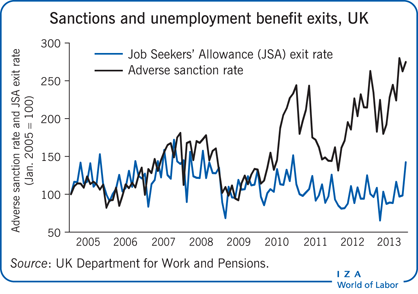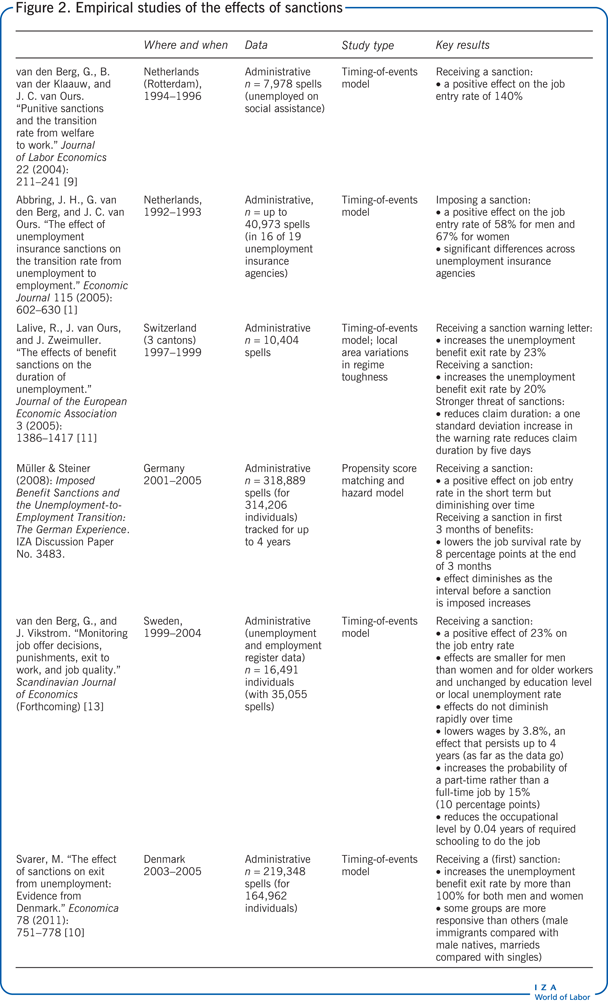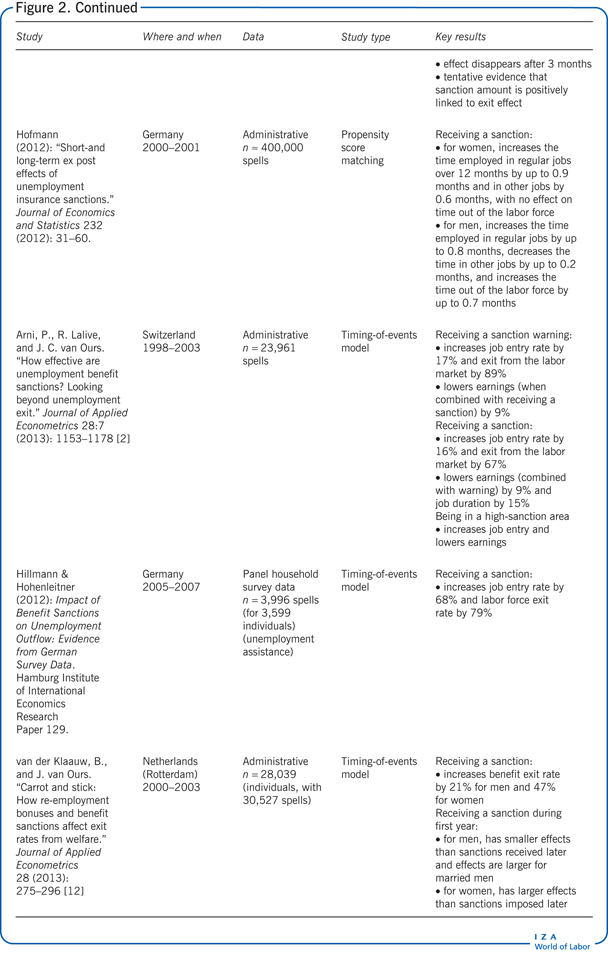Elevator pitch
Unemployment benefits often reduce incentives to search for a job. Policymakers have responded to this behaviour by setting minimum job search requirements, by monitoring to check that unemployment benefit recipients are engaged in the appropriate level of job search activity, and by imposing sanctions for infractions. Empirical studies consistently show that job search monitoring and benefit sanctions reduce unemployment duration and increase job entry in the short term. There is some evidence that longer-term effects of benefit sanctions may be negative.

Key findings
Pros
Most developed countries have some form of job search monitoring for unemployment benefit recipients and a system of benefit sanctions for infractions.
Even just the threat of benefit sanctions can reduce unemployment duration and increases job entry rates.
Being sanctioned reduces unemployment duration following the sanction and increases the rate of job entry.
Job search monitoring leads to shorter unemployment duration and higher job entry rates in the short term.
There is enough evidence to question recent moves in some countries to relax such measures.
Cons
There is some evidence that being sanctioned can lead to withdrawal from the labor force and a reduction in post-unemployment earnings.
More research is needed to examine the effects of monitoring and sanctions in a wider range of contexts, on a wider range of outcomes, and over a longer time frame.
Author's main message
Evidence is growing that job search monitoring and benefit sanctions for infractions reduce the duration of unemployment and increase the rate of job entry. There is also some evidence that such measures can drive people out of the labor force and may reduce the quality of job matches. Substantial gaps in the evidence base remain, however. Nevertheless, there is enough evidence to question recent moves in some countries to relax such measures.
Motivation
Job search monitoring and sanctions for failing to search actively enough are widely used in Organisation for Economic Co-operation and Development (OECD) countries. These measures are intended to counteract the search disincentive effects of unemployment insurance. But do they work?
Economic theory posits that such measures will increase search intensity and reduce the reservation wage (the wage below which a person prefers to remain unemployed), thereby increasing the exit rate from unemployment benefits and the job entry rate [1]. Unlike with training programs, there is no reason to expect lock-in effects—effects that reduce job search while people are participating in the program—from monitoring and sanctions [2]. On the other hand, tougher monitoring or stricter sanctions may lead job seekers to substitute formal (monitored) job search for informal (unmonitored, such as word-of-mouth) job search, which could have ambiguous effects on unemployment duration and job entry rates, depending on which type of search is more effective [2]. Further, the reduction in the reservation wage may lead to lower-quality job matches. Monitoring and sanctions might also drive some unemployed workers out of the labor force altogether.
This theoretical ambiguity makes empirical evidence particularly important. There is a growing body of studies that provides credible evidence, although substantial gaps remain. This paper reviews this literature on the effects of monitoring and sanctions, restricting attention to studies published in peer-reviewed journals, together with a handful of recently released working papers. The literature is fairly young—in part reflecting the newness of these measures—with most studies published in the last ten years.
Discussion of pros and cons
Most unemployment benefit systems have had basic eligibility requirements since their inception, such as being available for work, registering with the employment service, and accepting suitable job offers. But only since the mid-1990s have most OECD countries coupled these requirements with monitoring and sanctions.
The regularity of monitoring and the toughness (duration, coverage, and severity) of sanctions vary across countries and over time within countries. For example, Portugal requires fortnightly proof of job search activity at face-to-face meetings with advisors, and benefits are cancelled for refusing a placement or suitable job offer or for failing to provide sufficient evidence of job-searching. In contrast, Sweden requires no proof of job search activity, and sanctions entail only partial reductions in benefits, and only for a limited period. There is also variation across and within countries in the extent to which sanctions are enforced, although this is more difficult to quantify. This variation may itself be associated with the toughness of sanctions and other aspects of the unemployment insurance regime, such as the duration of benefits.
Empirical evidence on the impact of search monitoring
Although there is an extensive empirical literature on the combined effects of reforms of search requirements, monitoring, and search assistance for unemployment benefit recipients, there are fewer studies that separately distinguish the effects of changes in job search monitoring from changes in these other aspects of the benefit regime. This literature has focused on the effects of monitoring on benefit recipients, mostly ignoring potential monitoring effects on inflows to unemployment, with partial exceptions [3], [4].
Six studies that credibly separate the effects of monitoring from those of other aspects of unemployment insurance reform packages and from selection effects are reviewed here (Figure 1). Three of the studies randomly assigned subjects into treatment and control groups (randomized controlled trials)—two in the US and one in Hungary. The remaining three studies used quasi-experimental approaches that exploit non-random but plausibly exogenous assignment to treatment and control groups to identify monitoring effects.

Four of the six studies report positive and statistically significant effects of job search monitoring on unemployment exit rates and/or job entry rates, corresponding with reduced unemployment duration. The magnitude of these estimated effects vary—there are differences in the extent of the changes in monitoring being studied—but in a fairly narrow range. For example, one study finds that tougher monitoring leads to a 10% reduction in unemployment benefit duration [3], another finds a 10–16% reduction in unemployment duration [5], and a third finds a 23% increase in the probability of finding employment within eight months [6].
The other two studies report positive but statistically insignificant monitoring effects on unemployment exit rates or job entry rates. In one case, this may reflect the combination of small sample size and fairly minor changes to monitoring intensity [7]. The other study, which examines a larger change in monitoring intensity, also finds no overall statistically significant effect but does report statistically significant and positive effects on job entry rates for women aged 30 years and above [8]. It also finds evidence that the size of the monitoring effect on job entry varies negatively with the local unemployment rate.
A few of the studies look at the effects of monitoring on other outcomes, with mixed results. One finds a significant effect on switching from unemployment benefits to other welfare benefits, interpreted as a move out of the labor market [5]. Another finds no effect on dropping out of the labor force [6]. One study examines monitoring effects on earnings in the year following the initiation of the unemployment insurance claim, and finds little impact [3]. It also finds no significant effect on the probability of re-entering unemployment within a year. Another study finds a small reduction in inflows to unemployment resulting from suspension of search monitoring, perhaps caused indirectly by reduced outflows from unemployment and the resulting removal of high-risk individuals from the at-risk population [4].
Empirical evidence on the effect of benefit sanctions
The sanctions literature has concentrated on estimating the effects of sanctions imposed on current recipients of unemployment benefits, mostly ignoring the effect of eligibility restrictions (such as voluntarily leaving a job) on inflows. Sanctions on unemployment benefit recipients can be imposed for failing to search actively for a new job, rejecting a suitable job offer or offer of a placement in an employment or training program, and for violating other administrative requirements, such as failing to show up for advisor interviews.
Both the threat of sanctions (the ex ante or threat effect) and the imposition of sanctions (the ex post effect) can affect the behavior of unemployed workers receiving benefits. Most of the sanctions literature focuses on the ex post effects, despite the potential importance of ex ante effects. In jurisdictions where workers who have committed an unemployment insurance program infraction receive warning letters before a sanction is imposed, the ex post sanction effect can be separated into a warning effect (that a sanction is or may be coming) and an imposition effect once the sanction has been imposed.
Figure 2Figure 3 summarizes ten empirical studies of the effects of sanctions that have a clear strategy for dealing with the main identification problem: separating the effects of sanctions from the effects of differences in observed and unobserved characteristics between unemployed workers who receive a sanction and those who do not (selection effects). Specifically, it seems likely that unemployed workers who receive a sanction have characteristics that would otherwise reduce their probability of unemployment exit or job entry [9], [10]. Failure to account for this selection effect is likely to lead to underestimates of the effects of benefit sanctions on these outcomes.


In the absence of randomized controlled trials of sanctions, the studies rely on econometric analysis of administrative data, and most use the timing-of-events approach to estimate the ex post effects of sanctions. This approach exploits the exact timing of sanction events to identify causal effects. Although the approach is not without its critics, it is widely used and accepted, and its advantages generally outweigh its disadvantages.
All of the in-scope studies examine effects of sanctions using European data, and nearly all adopt the timing-of-events approach. These studies all find that receiving a sanction significantly increases the rate of exit from unemployment benefits, the rate of job entry, or both. The magnitude of these measured effects varies, but two upper-end estimates suggest that receiving a sanction more than doubles the unemployment benefit exit rate and the job entry rate [9], [10]. In Switzerland, unemployment benefit recipients receive sanction-warning letters in advance of the imposition of a sanction, so the two studies using Swiss data are able to separately identify the effect of receiving a warning letter from that of receiving a sanction [2], [11]. The studies find similar effects in both cases on the unemployment benefit exit rate and the job entry rate.
Some studies examine evidence for heterogeneous effects of receiving a sanction. Two find larger positive effects on the job entry rate and benefit exit rate for women than for men in the Netherlands [1], [12]. One of them also finds differences in sanction effects across different (sectoral) unemployment insurance agencies [1]. A study on Sweden also finds a positive effect of receiving a sanction on job entry that is larger for women than for men, as well as differences in effect by age, but no difference by education level or local unemployment rate [13]. A study for Germany finds differences in sanction effects by age, with increases in regular employment driven primarily by younger unemployed workers receiving sanctions. Male immigrants in Denmark are found to be more responsive to sanctions than native male Danes, and married workers are more responsive than unmarried [10].
Examinations of whether the effects of sanctions vary by when in the unemployment spell they are imposed find mixed results. For Germany, one study finds that the effect of sanctions is weaker the further into the unemployment benefits period it is imposed. A study for the Netherlands finds a similar pattern for women, but the opposite for men [12]. Two studies find that the effect of receiving a sanction diminishes over the time that has elapsed since the sanction was imposed. Another study finds no effect of elapsed time [13].
Although the duration and severity of sanctions vary across countries, other cross-country differences make it difficult to draw general conclusions about the relationships among sanction duration, severity, and effects from this source. Some studies have exploited within-regime variation in sanction severity to examine this issue—with, however, mixed findings. One study finds no evidence for significant differences in effects between sanctions of different severity, although there is only limited variation in sanction severity in their data [9]. A study on Denmark finds evidence that more severe sanctions may have larger effects on the exit rate from unemployment benefits [10].
A few studies look at the effects of sanctions on other outcomes. Some find significant positive effects of sanctions on the probability of leaving the labor market [2]. A study on Sweden finds negative effects of sanctions on post-unemployment wages—consistent with a reduction in the quality of job matches—and on hours worked [13]. It also finds that these negative effects persist, and that they may increase in magnitude for up to four years after the return to work. A study on Switzerland finds a negative effect on post-unemployment wages averaged over 30 months and a negative effect on job duration [2].
Because few people actually receive sanctions in most countries, some researchers argue that the main way sanctions influence behavior is through their threat effect. Evidence from laboratory experiments with students is consistent with this interpretation. Of the ten studies considered here, only two examine the effects of the threat of sanctions using observational data. One finds evidence of a shorter duration of unemployment benefits in areas in Switzerland where the threat of sanctions is stronger than elsewhere [11]. Another study, also on Switzerland, finds a similar result, along with a positive effect on job entry rates [2].
Limitations and gaps
Despite a high degree of internal validity and a high degree of agreement concerning the direction of effects on short-term outcomes, the evidence on job search monitoring and benefit sanctions remains limited. First, evidence is available only for a limited number of (mostly European) countries, often at a very local level within the country or for particular subgroups of unemployed workers, which makes it difficult to generalize about the magnitude of the effects. Second, the literature has focused on a limited set of outcomes, with few studies examining monitoring or sanction effects on earnings and other job quality measures, on exit to anything other than employment or just overall exits, or on inflows to unemployment. Third, only one study examines longer-term effects. Fourth, few studies examine evidence for heterogeneous treatment effects across different groups of unemployed workers or in different labor market contexts. Fifth, all the studies adopt a partial-equilibrium approach, ignoring the potential for offsetting general equilibrium effects. Sixth, few studies examine evidence for sanction warning effects, despite their potential importance.
Summary and policy advice
Job search monitoring and benefit sanctions increase the exit from unemployment benefits and job entry rates in the short term. With unemployment high in many OECD countries following the Great Recession, job search monitoring and benefit sanctions are likely to remain important policy tools. From this perspective, the fact that some OECD countries do not monitor the job search activities of unemployment benefit recipients or do not have strong sanctioning regimes in place appears puzzling, at first glance, as do recent moves in some countries (such as the Netherlands) to relax such measures. But there is also some evidence that monitoring and sanctions may have negative effects on labor force participation for some workers and, in the case of sanctions, on post-unemployment earnings in the longer term. Looking forward, policymakers will need to confront such trade-offs in the design and implementation of monitoring and sanctions policy. Substantial gaps in the evidence base remain, however, and research that addresses these gaps could influence future policy. Nevertheless, there is enough evidence to question recent moves in some countries to relax monitoring and sanctions.
Acknowledgments
The author thanks an anonymous referee and the IZA World of Labor editors for many helpful suggestions on earlier drafts. The usual disclaimers apply.
Competing interests
The IZA World of Labor project is committed to the IZA Guiding Principles of Research Integrity. The author declares to have observed these principles.
© Duncan McVicar